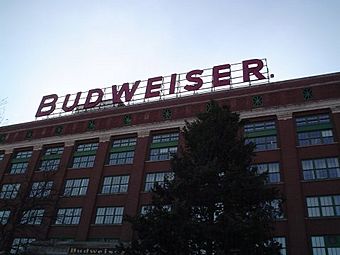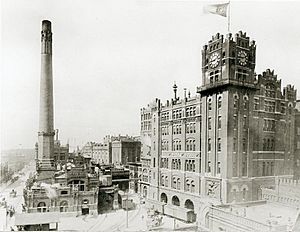Anheuser-Busch Brewery facts for kids
|
Anheuser-Busch Brewery
|
|

The packaging plant in St. Louis, Missouri
|
|
| Location | 721 Pestalozzi St. Louis, Missouri |
|---|---|
| Area | 142 acres (57 ha) |
| Built | 1875 |
| Architectural style | Romanesque |
| NRHP reference No. | 66000945 |
Quick facts for kids Significant dates |
|
| Added to NRHP | November 13, 1966 |
| Designated NHLD | November 13, 1966 |
Anheuser-Busch Brewery is a brewery complex in St. Louis, Missouri.
The brewery, opened in 1852 by German immigrant Adolphus Busch, is designated as a National Historic Landmark District. Free public tours of the brewery are given. The tour takes visitors through the complex, and those of the legal age can enjoy two free glasses of any Anheuser-Busch product in the Hospitality Room after the tour. Tourists can see beer being made and packaged in a working part of the brewery.
The company keeps a rotation of its famous Budweiser Clydesdales at its headquarters; the historic draft horses were originally used to pull wagons carrying beer in the 19th-century days of the company. Visitors to the brewery can observe the Clydesdales in their exercise field and see their places in the carriage house.
Some of the herd is kept at the company farm in St. Louis County. Known as Grant's Farm (having been owned by former President Ulysses S. Grant at one time), this complex is home to a menagerie of animals such as elephants, tortoises, and a variety of exotic hooved mammals. Since 2008, approximately half of the Budweiser Clydesdales are kept at the Warm Springs Ranch near Booneville, Missouri.
The brewery was designated a U.S. National Historic Landmark in 1966, recognizing the company's importance in the history of beer brewing and distribution in the United States. The landmarked area includes 189 structures spread over 142 acres (57 ha), including many red brick Romanesque ones "with square crenelated towers and elaborate details." The Brew House, built in 1891-1892, is particularly notable for its "multi-storied hop chandeliers, intricate iron-work, and utilization of natural light".





